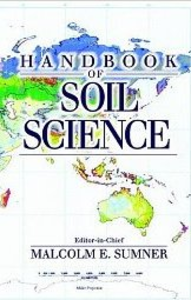Soil organic matter
Baldock, J.A., and Nelson, P.N. (2000) Soil organic matter. In: Sumner, Malcolm E., (ed.) Handbook of Soil Science. CRC Press, Boca Raton, FL, USA, B25-B84.
|
PDF (Published Version)
- Published Version
Restricted to Repository staff only |
||
![[img]](https://researchonline.jcu.edu.au/223/2.hassmallThumbnailVersion/223_baldock_%26_Nelson_2000_Book_cover.jpg)
|
Image (JPEG) (Book Cover)
- Cover Image
Download (16kB) |
Abstract
Research pertaining to the organic fraction of soils can be traced back in excess of 200 years. Achard (1786) isolated a dark amorphous precipitate upon acidification of an alkaline extract from peat. The effect of organic matter on soil N fertility (Liebig, 1840), and studies on the use of animal manures for maintaining soil fertility (Lawes, 1861) and the influence of soil and tree species on the development of humus form (Muller, 1887) demonstrated the importance of organic matter in soil processes. The advancement of organic chemical methodologies and confirmation of the presence of various chemical structures in soil organic matter, lead to theories that soil organic matter was composed of a heterogeneous mixture of dominantly colloidal organic substances containing acidic functional groups and N. More recently, the polyphenol theory was proposed in which quinone structures of lignin and microbial origin polymerize in the presence of N containing groups (amino acids, peptides, and proteins) to produce nitrogenous polymers (Flaig et al., 1975). The early research pertaining to soil organic matter has been reviewed by Stevenson (1994). While alkaline extraction of soil organic matter is still practiced, modern analytical techniques, including solid state 13C nuclear magnetic resonance spectroscopy (13C NMR), infrared spectroscopy (IR), and pyrolysis gas chromatography/mass spectroscopy (Py-GCMS) allow selective probing of the chemistry of soil organic matter within samples of whole soil, and avoid the problems of incomplete extraction, lack of biological significance, and artefact synthesis often ascribed to alkaline extraction procedures. The combination of these techniques with novel approaches capable of identifying biologically important fractions of soil organic matter has significantly advanced our knowledge of the organic fraction of soils and its dynamics over the last 20 years.
Despite such a long history of research and new methodological and technological advancements, many questions related to the genesis and chemical composition of organic materials in soils and their impacts on soil fertility, soil pedogenesis, and soil physical and chemical properties persist today. Many excellent texts and review papers have been written on the topic of soil organic matter; some of the more recent of these are given in Table 2.1.
An examination of terms used to describe soil organic matter and its components in the literature revealed a lack of precise definitions of what soil organic matter and its various fractions represent. Such a problem exists because of the heterogeneity of organic material found in soil in terms of its source, chemical and physical composition, diversity of function, and dynamic, ever-changing character. The term soil organic matter has been used to encompass all organic materials found in soil (Stevenson, 1994), excluding charcoal (Oades, 1988), or excluding non-decayed plant and animal tissues, their partial decomposition products, and the living soil biomass (McCarthy et al., 1990b). As suggested by McCarthy et al. (1990b), it is most important that readers establish how particular authors apply the various terms to fully understand and assess the implications of comments made. However, it is also important that a set of definitions for soil organic matter and its components is derived and applied consistently. The definitions of soil organic matter and its components to be utilized in this chapter (Table 2.2) have been derived Baldock and Nelson, SOM Chapter from several sources (Oades, 1988; McCarthy et al., 1990b; Stevenson, 1994) and are put forward in an effort to reduce existing variations in the use of the terms.
| Item ID: | 223 |
|---|---|
| Item Type: | Book Chapter (Research - B1) |
| ISBN: | 978-0-8493-3136-7 |
| Keywords: | review, soil chemistry, humus, decomposition, nuclear magnetic resonance, gas chromatography, mass spectrometry, infrared spectroscopy |
| Additional Information: | This publication does not have an abstract. The Introduction is displayed as the abstract. |
| Date Deposited: | 13 Sep 2006 |
| FoR Codes: | 05 ENVIRONMENTAL SCIENCES > 0503 Soil Sciences > 050304 Soil Chemistry (excl Carbon Sequestration Science) @ 100% |
| SEO Codes: | 96 ENVIRONMENT > 9614 Soils > 961499 Soils not elsewhere classified @ 100% |
| Downloads: |
Total: 1461 Last 12 Months: 23 |
| More Statistics |



